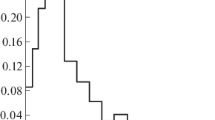Abstract
The effectiveness of the wide application of the theory of branching random processes to the description of neutron behavior is due to the adequacy of the model and the real microscopic processes occurring in the reactor. However, the classical theory of branching process cannot describe effects which are important for reactors working at power, such as the influence of control and feedbacks. Recently, a class of branching processes with a variable regime was introduced and investigated. The application of the results of these works to simulation of the behavior of the neutron population in reactors with control and feedbacks makes it possible to determine precisely and to describe the phenomena which are important for reactor operation and which deterministic methods and the classical theory of branching processes do not reveal and cannot describe. Three regimes of the critical behavior of reactors are found: they depend on the sign of the controlling actions and the feedbacks. It is found that various parameters influence the operating regime of reactors. Explicit expressions are given for the generating functions of the random power of a reactor in regimes admitting stationary solutions. For the nonstationary regimes, asymptotic expressions are written for the average value and the variance of the power.
Similar content being viewed by others
REFERENCES
V. A. Vatutin, T. M. Televinova, and V. P. Chistyakov, Probabilistic Methods in Physical Research, Nauka, Moscow (1985).
V. I. Dorogov and V. P. Chistyakov, Probabilistic Models of Particle Transformations, Nauka, Moscow (1988).
B. A. Sevast'yanov, Branching Processes, Nauka, Moscow (1971).
R. V. Boiko, “Behavior of branching processes with immigration in a stimulating medium,” Ukr. Matem. Zh., 37, No. 4, 423–430 (1985).
R. V. Boiko and V. V. Ryazanov, “Stochastic calculation of the strategy and criteria for safety of nuclear-reactor control,” in: Safety of Nuclear Power Plants, Part 3. States and Problems of Scientific-Research and Design-Construction Work Ensuring Safety of Nuclear Power Plants. Scientific and Practical Conference, NTTsBAÉ pri Gospromatomnadzore SSSR, Moscow, April 1989.
R. V. Boiko and V. V. Ryazanov, “Stochastic simulation of near-critical and critical behavior of nuclear reactors,” Vestsi Akadémii Navuk BSSR. Ser. Fiz. Énerg. Navuk, No. 3, 10–15 (1990).
S. L. Rivkin and A. A. Aleksandrov, Handbook of Thermodynamic Properties of Water and Water Vapor, Énergoatomizdat, Moscow (1984).
V. I. Vladimirov, Practical Problems Concerning the Operation of Nuclear Reactors, Énergoatomizdat, Moscow (1985).
G. A. Bat' (ed.), Principles of the Theory and Methods for Calculating Nuclear Power Reactors, Énergoatomizdat, Moscow (1982).
D. Hetrik, Dynamics of Nuclear Reactors [Russian translation], Atomizdat, Moscow (1975).
J. Kipin, Physical Principles of Kinetics of Nuclear Reactors [Russian translation], Énergoatomizdat, Moscow (1984).
A. A. Sarkisov and V. N. Puchkov, Physics of Transient Processes in Nuclear Reactors, Énergoatomizat, Moscow (1983).
R. Urig, Statistical Methods in Nuclear-Reactor Physics, Atomizdat, Moscow (1974).
A. Z. Patashinksii and V. L. Pokrovskii, Fluctuation Theory of Phase Transitions, Nauka, Moscow (1975).
S. Ma, Modern Theory of Critical Phenomena [Russian translation], Mir, Moscow (1980).
V. G. Boiko, V. M. Sysoev, and A. S. Chalyi, “Metastable states, fluctuations, thermodynamics, and fractals,” Preprint ITF-88-155 R, Institute of Theoretical Physics, Academy of Sciences of the Ukrainian SSR, Kiev (1988).
N. S. Postnikov, “Dynamical chaos in a reactor with nonlinear feedbacks,” At. Énerg., 74, No. 4, 328–334 (1993).
N. S. Postnikov, “Spatiotemporal chaos in distributed models of a reactor,” At. Énerg., 86, No. 6, 450–453 (1999).
N. S. Postnikov, “Conditions for the existence of chaotic oscillations in nuclear reactors,” At. Énerg., 88, No. 6, 432–438 (2000).
N. S. Postnikov, “Pulsed turbulence of the neutron field in nuclear reactors,” At. Énerg., 91, No. 6, 434–438 (2001).
U. Kunze, “Application of noise diagnostics to plant monitoring in the Greifswald nuclear power plant Bruno Leuschner,” Kernenergie, 32, No. 8, 329–333 (1989).
V. D. Goryachenko, Qualitative Methods in the Dynamics of Nuclear Reactors, Énergoatomizdat, Moscow (1983).
A. Yu. Loskutov and A. S. Mikhailov, Introduction to Synergetics, Nauka, Moscow (1990).
B. M. Smirnov, “Fractal clusters,” Usp. Fiz. Nauk, 149, No. 2, 177–219 (1986).
Author information
Authors and Affiliations
Rights and permissions
About this article
Cite this article
Boiko, R.V., Ryazanov, V.V. Stochastic Model of a Nuclear Power Reactor. Atomic Energy 93, 625–634 (2002). https://doi.org/10.1023/A:1021088513565
Issue Date:
DOI: https://doi.org/10.1023/A:1021088513565



